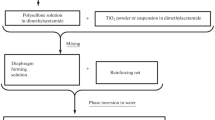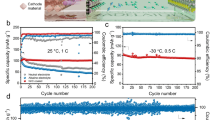Abstract
Zinc-bromine alkali-salt membrane-type chemical power cell was assembled and studied. The open-circuit voltage (OCV) of the zinc-bromine alkali-salt membrane chemical power cell (CPC) was experimentally obtained (2.30 V). This value is close to the theoretically calculated value of the electromotive force (EMF) of the cell (2.27 V) and exceeds the EMF and OCV of many known power cells using a single homogeneous-composition aqueous electrolyte and having no ion-exchange membrane. The maximum theoretical specific energy of the zinc-bromine alkali-salt membrane CPC is 317.3 W h kg–1, which is lower that the corresponding values for the zinc-silver and zinc-nickel power cells and exceeds that of nickel-iron, nickel-cadmium, and lead sulfuric acid CPCs. It is shown that the cell under study can be used as an electric battery.
Similar content being viewed by others
References
US Patent 4 510 218 (publ. 1985).
US Patent 4 824 743 (publ. 1989).
Tomazic, G.S., Proc. 11th Int. Electric Vehicles Symp., Italy, 1992, pp. 79–85.
Handbook of Batteries, Linden, David, Ed., New York: McGrawHill, Inc., 1995, 2nd ed.
Khimicheskie istochniki toka. Spravochnik (Chemical Power Cells), Korovin, N.V. and Skundin, A.M., Eds., Moscow: Izd. Mosk. Energet. Inst., 2003.
Jae-Deok Jeon, Hyeon Sun Yang, Joonmok Shim, Hyun Sik Kim, and Jung Hoon Yang, Electrochim. Acta, 2014, vol. 127, pp. 397–402.
Liqun Zhang, Huamin Zhang, Qinzhi Lai, Xianfeng Li, and Yuanhui Cheng, J. Power Sources, 2013, vol. 227, pp. 41–47.
Chenhui Wang, Xianfeng Li, Xiaoli Xi, Wei Zhou, Qinzhi Lai, and Huamin Zhang, Nano Energy, 2016, vol. 21, pp. 217–227.
Hyeon Sun Yang, Jong Ho Park, Ho Won Ra, Chang-Soo Jin, and Jung Hoon Yang, J. Power Sources, 2016, vol. 325, pp. 446–452.
Turaev, D.Yu., Russ. J. Appl. Chem., 2005, vol. 78, no. 10, pp. 1615–1619.
Ponomarev, A.N., Moskvin, Yu.L., and Babenko, S.D., Russ. J. Electrochem., 2007, vol. 43, no. 3, pp. 290–295.
RU Patent 2 131 633 (publ. 1999).
RU Patent 2 239 260 (publ. 2004).
Handbook of Electrochemistry, Cynthia G. Zoski, New Mexico State University, Department of Chemistry and Biochemistry, Las Cruces, New Mexico, USA, 2007, 1st ed.
Activity Coefficients in Electrolyte Solutions, Pitzer, K.S., Ed., CRC Press, Boca Raton, FL, 1991, 2nd ed.
Spravochnik po elektrokhimii (Handbook of Electrochemistry), Sukhotin, A.M., ED., Leningrad: Khimiya, 1981.
Handbook of Batteries, David Linden and Thomas B. Reddy, McGraw–Hill Professional, 2002, 3rd ed.
Author information
Authors and Affiliations
Corresponding author
Additional information
Original Russian Text © D.Yu. Turaev, 2018, published in Zhurnal Prikladnoi Khimii, 2018, Vol. 91, No. 7, pp. 975−982.
Rights and permissions
About this article
Cite this article
Turaev, D.Y. Zinc-Bromine Alkali-Salt Membrane Chemical Power Cell. Russ J Appl Chem 91, 1112–1117 (2018). https://doi.org/10.1134/S1070427218070078
Received:
Published:
Issue Date:
DOI: https://doi.org/10.1134/S1070427218070078




